All the chaos and disturbance of urban living quietly gets washed away when you stand in front of a lake and allow its spirit to engulf you. For some time now, Bhaskar and I have been feeling the call of lakes. It is a call which could not be ignored anymore. Introduced to lakes by Ramesh Sivaram (Visit to Kaikondanahalli lake), our journey began very recently, with baby steps taking us from one lake to another, trying to understand what ails our lakes and what can be done about it. This writeup is an attempt to document our learning and to share it with others who, like us, are interested to get involved in lake rejuvenation.
The interconnection of lakes
Ramesh always says that each lake is different and has a story of its own; lake rejuvenation cannot therefore be generalised beyond a certain extent. So we decided to visit multiple lakes (23 till now) and see how our understanding emerges. Although our interest with lakes began with the Chunchaghatta lake, we soon realised that it is not enough to isolate a lake, call it “mine” and push for its rejuvenation, ignoring the other lakes connected to it. Therefore, we began by visiting the lakes connected to Chunchaghatta lake (Kothnur lake in the upstream and Sarakki lake in the downstream). In case of these lakes, the BDA has rightly begun by restoring the Kothnur lake, so that the water flowing into the Chunchaghatta lake from the Kothnur lake will not be contaminated. However, the Chunchaghatta lake restoration has not even begun, while efforts are on to revive Sarakki lake, which will not be complete until and unless the upstream Chunchaghatta lake is rejuvenated.
The autority working on any particular lake (BDA, BBMP, LDA and KFD) will be able to tell you the other interconnected lakes in the series, and it might help to begin with the lake which is upstream in the series.
Understanding Detailed Project Report (DPR)
Unlike other social initiatives, lake restoration cannot be taken up by a lay person on his own. Before a lake is taken up for rejuvenation, a Detailed Project Report (DPR) has to be prepared and presented to the regulator, the Lake Development Authority (LDA). The DPR is prepared by the authority in charge of the lake, through an external consultant. LDA’s Technical Committee will review before approving it. At present, 123 lakes come under the BDA, 55 come under the BBMP, 6 under the LDA and 5 under the Karnataka Forest Department (KFD).
In order to understand what lake rejuvenation is all about, we wanted to look through the DPR of the Chunchaghatta lake. The formal process would be to file an RTI, which we did. However, the BDA was unable to give us a copy. So, we went directly to the LDA and got a photocpy of the Chunchaghatta lake’s DPR without much trouble. However, getting the DPR is only one part of the story. The other, and more difficult part, was making sense of it! This particular DPR is badly written and cluttered. Reading it made me suddenly realize why most volunteers prefer to restrict their involvement in lake restoration to clean up drives!
Frustrated over not being able to make sense of the DPR we had, we went crying back to Ramesh. He handed us a much better DPR of one of the lakes where his team is working. Pouring over the two DPRs, we figured a few things in bits and pieces. In simple words, DPRs have to clearly explain the current status of the lake through survey, morphometric analysis, details of inlets, outlets and encroachment information. The objective of rejuvenating the lake has to be cleary stated. A detailed cost estimation needs to be prepared and an action plan about the core and non-core components of lake restoration needs to be in place to undertake the work. Civilians are welcome to make suggestions on the DPR to the authority concerned and work with them on implementation. Forming neighbourhood Trusts or Associations are being encouraged by authorities for monitoring and maintenance of rejuvenated lakes.
What ails our lakes?
No matter how much material we read to learn about lakes, to fully understand what is killing our lakes, we need to step on the ground and see it ourselves. Also we need to spend time with people who work on the ground like Ramesh Sivaram and Mr.Ram Murthy to really deepen our understanding. This is what took Bhaskar and me from one lake to another, photographing, taking videos, interacting with locals, speaking to experts, and also understanding the authority’s (in our case BDA) point of view. From the little that we have understood so far, the basic issues that need to be set right are the following:
-
Preventing sewage from entering lakes
-
Removing encroachments – from Storm Water Drains, buffer zone & lake
As simple as these might seem, it is only when we get deeper, that we realize how complicated things have become.
Underground Sewage system and Storm Water Drain (SWD)
There are two types of drains, meant to handle the rain water and sewage seperately. Rain water is meant to be channelized into lakes through open Storm Water Drains (SWDs) and Raja Kaluves, the main drains connecting lakes. These open drains are not meant to carry sewage or any form of waste at all. For carrying sewage, we are meant to have underground sewage pipelines which carry sewage from households to Sewage Treatment Plants (STPs). Rain water should not be let into the underground sewage system which overloads the STPs. Unfortunately, both systems are being wrongly used. Not many of us are aware that all the open drains with black water that we see around us are meant to carry only rain water. What we call mori or charandi are not sewage drains, but storm water drains!
Our understanding of the severity of sewage entering lakes deepened during one of our lake tours when we bumped into Mr. Ram Murthy. Aged 65, with the energy of a 16 year old, he led us on his bike to see the mother of all drains – the ones flowing into Bellandur lake. Strangely unnoticed in Koramangala is the grand Sangam of two large Raja kaluves carrying storm water and sewage, one coming from Agara and the other, from Koramangala. It was absolutly shocking to see how sewage flows like a river, so openly, into the Bellundur lake. Mr. Ram Murthy spent almost the entire day sharing with us his learning and experiences (he has been working on waking up authorities to Bellundur lake since 1996!).
Despite the court order clearly stating that no sewage is to be let into lakes, just about every SWD has sewage flowing through it. Sewage enters lakes through any of the following ways:
-
Sewage from houses is directly let into raja kaluves
-
Sewage pipelines are connected to raja kaluves
-
Sewage from nearby houses enter the lake directly(as in the case of Chunchughatta & ISRO)
-
In some lakes, we have witnessed tanks carrying sewage and industrial effluents, directly being emptied into lakes (Konappana Agrahara)
Resolving the problem is trickier than it seems
-
Even through technology to treat sewage is available, in Bangalore, STPs are mostly a failure. The classic case being the STP near Bellandur lake.
-
As mentioned in the report of the committee constituted by the Hon’ble High Court of Karnataka to examine ground realities and prepare an action plan for preservation of lakes in Bangalore “There is no point in de-silting and other developments, if lake continues to receive polluted water. Diverting sewage is not an option in the absence of other inlets into the lake to bring rainwater. Diverting sewage is leading to drying of lakes as in case of Doddabommasandra lake, Agara lake etc.”
-
Many homes and apartments are not connected to underground sewage pipelines and instead directly let the sewage into SWDs and lakes, making it even more complicated to prevent sewage directly entering lakes
-
Focusing on only one lake in the series and diverting sewage into the next downstream lake is a band-aid solution which will come back to haunt us another time
Excess sewage entering lakes means that fish and aquatic animals cannot survive, which in turn affects the presence of birds. In addition, lakes get eaten up by weeds due to Eutrophication (excessive nutrients entering the lakes through sewage). Other obvious problems are unpleasant odor and contamination of the ground water.
Bangalore has about 840 kilometres length of primary and secondary drains. Ramesh and team have been pushing the authorities to undertake a complete survey of the SWDs as a first step to addressing this issue.
Encroachment of Storm Water Drains, buffer zone & lake
Come monsoon, and we read stories of layouts being submerged in water and complaints to the BBMP for not acting. Yet, we do not realize that the reason for much of this is that Rajakaluves are encroached and buildings have been constructed in their place, obstructing the natural flow of water into lakes, flooding layouts and roads.
The lakes in Bangalore were originally created keeping in mind the natural valley system, with the adjoining land used for irrigation purposes. Karnataka High court has clearly stipulated that 30m from the lake boundary is to be a no-development buffer zone. For large lakes, the buffer zone is greater. Yet, it is rare to find lakes without encroachment. In some cases, it will be the encroached party (apartments, residents) who form the Neighbourhood Trust and claim to be working on rejuvenating the lake.
Relentless efforts by residents to stop encroachment in cases of lakes like Mestripalya is what has led to the authorities finally taking note and working on rejuvenating the dead lake.
How to mess up a lake restoration
Having had some understanding of what are the basics to be kept in mind, it is equally enlightening to know how not to restore a lake! A great lesson in this direction has been the visit to ISRO lake in Kumaraswamy layout. In these pics you will see how focus has been on making walkways, colorful benches and other external beautification, while all basics have been ignored.

Almost all houses along the periphery of the lake (which are clearly encroached) let their sewage directly into the lake
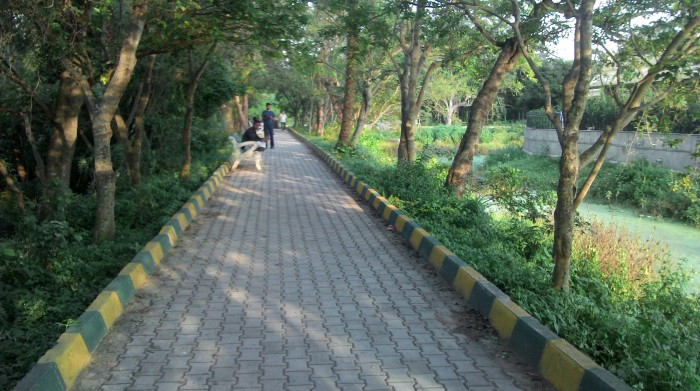
The walkways have been made such that they cut across the lake, separating the otherwise beautifully wild sections from the lake bed!
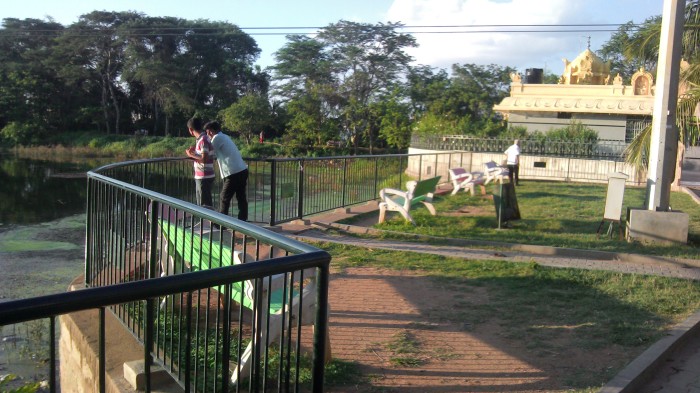
People seem to happily use the walkways and benches, completely ignoring that what they are so enjoying is in fact the beautiful sight and aroma of sewage!
Finally, while lake rejuvenation also involves fixing lake boundaries, fencing, de-weeding, de-silting, beautification, etc., the primary issues that need to be addressed on priority are the sewage entry and encroachment removal. As Mr. Ram Murthy says, working on lake rejuvenation, without fixing these basic issues, is like decorating a dead body!
***
The lakes we have visited for our understanding include Kalena Agrahara, Subbarayana kere, Gottigere, Kammanahalli, Hulimavu, Arekere, Kothnur, Chunchaghatta, Sarakki, Doddakalasandra, Konanakunte, Avalahalli, Gubbalala, Talaghattapura, Garvebhavipalya, Maestripalya, Rayasandra, Konapanna Agrahara, Doddanagamangala, Byrasandra, Hosakerehalli, Vasanthnagar, ISRO. Local Trusts and Associations are already working on many of these lakes and this information is easily available on googling.
Information on these lakes, pictures and videos are be available on our facebook page.
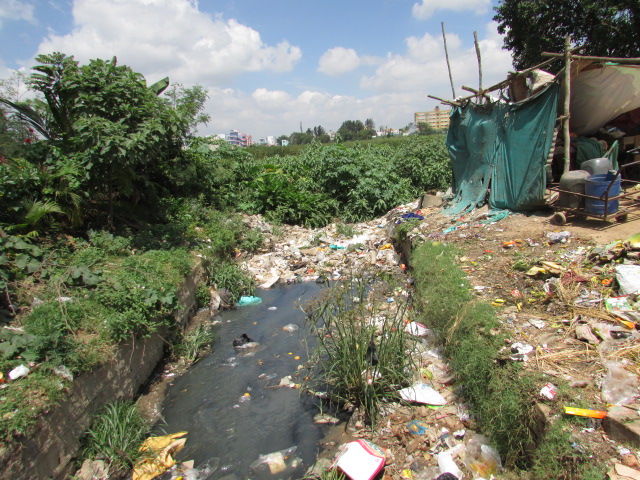
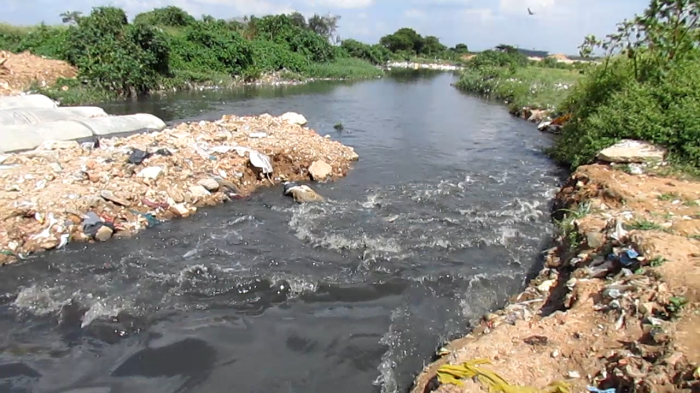
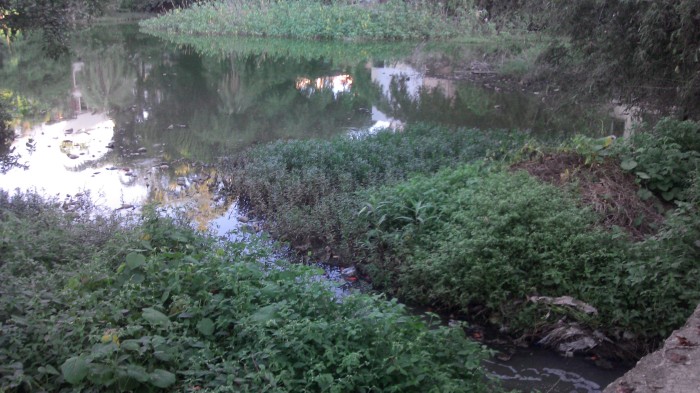
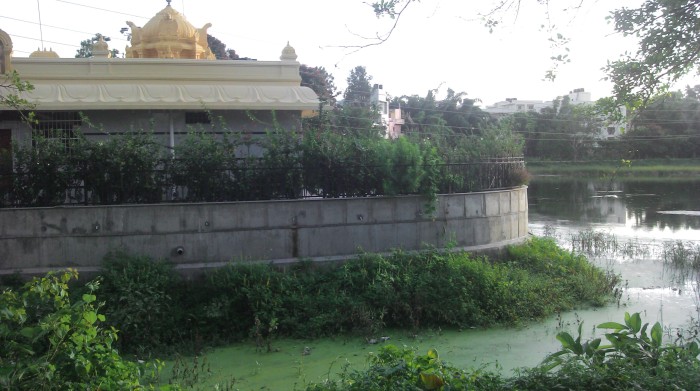

Very interesting article Sinu. Thank you for your reportage on this critical issue. I am interested in knowing more about how citizens can take a proactive role in rejuvenating lakes in a variety of capacities… Thoughts?
Dear Ridhi,you could begin by deciding which lake/series of lakes you wish to be involved in, interact with the locals there to understand what has been happening and meet the authority in charge (BDA, BBMP) to know the status of rejuvenation work planned. If there are existing groups for the lake, they should be able to connect you to them.
Well written, the message comes across very simply and clearly. Pictures are eye openers. I am from a group working on the restoration of Devarabisanahalli Lake, and possibly Sowle kere which is the upstream lake for us. We have just started, and its a long way to go! 🙂
strongly agreed with your point that you should not generalise the lake rejuvenation activity without understanding the inflow and outflow of water from the lake. Types of impurities, sources is equally important. Well described what exactly needed to start lake rejuvenation project